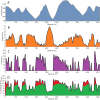Preparing for the Nordic Skiing Events at the Beijing Olympics in 2022: Evidence-Based Recommendations and Unanswered Questions
- PMID: 38624672
- PMCID: PMC8107804
- DOI: 10.1007/s42978-021-00113-5
Preparing for the Nordic Skiing Events at the Beijing Olympics in 2022: Evidence-Based Recommendations and Unanswered Questions
Abstract
At the 2022 Winter Olympics in Beijing, the XC skiing, biathlon and nordic combined events will be held at altitudes of ~ 1700 m above sea level, possibly in cold environmental conditions and while requiring adjustment to several time zones. However, the ongoing COVID-19 pandemic may lead to sub-optimal preparations. The current commentary provides the following evidence-based recommendations for the Olympic preparations: make sure to have extensive experience of training (> 60 days annually) and competition at or above the altitude of competition (~ 1700 m), to optimize and individualize your strategies for acclimatization and competition. In preparing for the Olympics, 10-14 days at ~ 1700 m seems to optimize performance at this altitude effectively. An alternative strategy involves two-three weeks of training at > 2000 m, followed by 7-10 days of tapering off at ~ 1700 m. During each of the last 3 or 4 days prior to departure, shift your sleeping and eating schedule by 0.5-1 h towards the time zone in Beijing. In addition, we recommend that you arrive in Beijing one day earlier for each hour change in time zone, followed by appropriate timing of exposure to daylight, meals, social contacts, and naps, in combination with a gradual increase in training load. Optimize your own individual procedures for warming-up, as well as for maintaining body temperature during the period between the warm-up and competition, effective treatment of asthma (if necessary) and pacing at ~ 1700 m with cold ambient temperatures. Although we hope that these recommendations will be helpful in preparing for the Beijing Olympics in 2022, there is a clear need for more solid evidence gained through new sophisticated experiments and observational studies.
Keywords: Altitude; Biathlon; COVID-19; Cold temperatures; Jet lag; Nordic combined.
© The Author(s) 2021.
Conflict of interest statement
Conflict of interestThe authors have no conflicts of interest to declare.
Figures


Similar articles
-
Altitude training considerations for the winter sport athlete.Exp Physiol. 2010 Mar;95(3):411-21. doi: 10.1113/expphysiol.2009.050377. Epub 2009 Oct 16. Exp Physiol. 2010. PMID: 19837773 Review.
-
Evolutions in the physiology of skiing, skating and running in the Olympics.J Sports Med Phys Fitness. 2019 Jul;59(7):1175-1194. doi: 10.23736/S0022-4707.18.08977-6. Epub 2018 Oct 10. J Sports Med Phys Fitness. 2019. PMID: 30317836 Review.
-
International Olympic Committee consensus statement on thermoregulatory and altitude challenges for high-level athletes.Br J Sports Med. 2012 Sep;46(11):770-9. doi: 10.1136/bjsports-2012-091296. Epub 2012 Jun 9. Br J Sports Med. 2012. PMID: 22685119
-
Influence of Beijing Winter Olympic Games Construction on Vegetation Coverage around Zhangjiakou Competition Zone.Int J Environ Res Public Health. 2021 Dec 3;18(23):12777. doi: 10.3390/ijerph182312777. Int J Environ Res Public Health. 2021. PMID: 34886500 Free PMC article.
-
Analysis of a Biathlon Sprint Competition and Associated Laboratory Determinants of Performance.Front Sports Act Living. 2019 Nov 12;1:60. doi: 10.3389/fspor.2019.00060. eCollection 2019. Front Sports Act Living. 2019. PMID: 33344983 Free PMC article.
Cited by
-
Preparing for snow-sport events at the Paralympic Games in Beijing in 2022: recommendations and remaining questions.BMJ Open Sport Exerc Med. 2022 Feb 22;8(1):e001294. doi: 10.1136/bmjsem-2021-001294. eCollection 2022. BMJ Open Sport Exerc Med. 2022. PMID: 35295372 Free PMC article. Review.
References
-
- Beelen A, Sargeant AJ. Effect of lowered muscle temperature on the physiological response to exercise in men. Eur J Appl Physiol Occup Physiol. 1991;63(5):387–92. 10.1007/bf00364467. - PubMed
-
- Bergeron MF, Bahr R, Bärtsch P, Bourdon L, Calbet JA, Carlsen KH, Castagna O, González-Alonso J, Lundby C, Maughan RJ, Millet G, Mountjon M, Racinais S, Rasmussen P, Singh DG, Subudhi AW, Young AJ, Soligard T, Engebretsen L. International Olympic Committee consensus statement on thermoregulatory and altitude challenges for high-level athletes. Br J Sports Med. 2012;46(11):770–9. 10.1136/bjsports-2012-091296. - PubMed
-
- Bolger CM, Kocbach J, Hegge AM, Sandbakk O. Speed and heart-rate profiles in skating and classical cross-country skiing competitions. Int J Sports Physiol Perform. 2015;10(7):873–80. 10.1123/ijspp.2014-0335. - PubMed
-
- Breitschädel F, Klein-Paste A, Loset S. Effects of temperature change on cross-country ski characteristics. Procedia Eng. 2010;2(2):2913–8. 10.1016/j.proeng.2010.04.087.
-
- Broatch JR, Bishop DJ, Zadow EK, Halson S. Effects of sports compression socks on performance, physiological, and hematological alterations after long-haul air travel in elite female volleyballers. J Strength Cond Res. 2019;33(2):492–501. - PubMed
LinkOut - more resources
Full Text Sources
